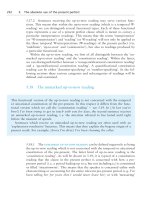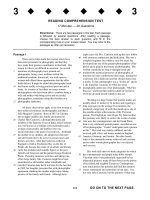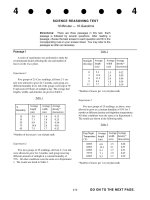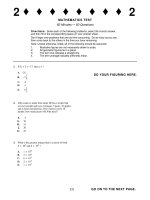ENGLISH TEST 23 Minutes — 38 Questions pot
Bạn đang xem bản rút gọn của tài liệu. Xem và tải ngay bản đầy đủ của tài liệu tại đây (26.37 KB, 8 trang )
1 ■ ■ ■ ■ ■ ■ 1
182 GO ON TO THE NEXT PAGE.
ENGLISH TEST
23 Minutes — 38 Questions
Directions: In the following three passages, certain
words and phrases have been underlined and
numbered. You will find alternatives for each
underlined portion in the right-hand column. Select
the one that best expresses the idea, that makes the
statement acceptable in standard written English, or
that is phrased most consistently with the style and
tone of the entire passage. If you feel that the original
version is best, select “NO CHANGE.” You will also
find questions asking about a section of the passage
or about the entire passage. For these questions,
decide which choice gives the most appropriate
response to the given question. For each question in
the test, select the best choice and fill in the
corresponding space on the answer sheet. You may
wish to read each passage through before you begin
to answer the questions associated with it. Most
answers cannot be determined without reading
several sentences around the phrases in question.
Make sure to read far enough ahead each time you
choose an alternative.
Passage I
Since primitive times,
societies have had their own
1
legends
fictitious stories handed down by tradition
1
and popularly accepted as historical. Even before the
development of written language, cultures would pass
down these popular stories orally. While such tall tales
may appear merely whimsical in nature, they actually
perform a useful function.
Other things can be useful as
2
well.
Perhaps even more important than their
2
entertainment
value and worth is
the cohesive role that
3
legends play. They provide the members of a society with
a common grounding, a story in which we recognize
amidst our differences the characteristic quirks that make us
members of a particular culture.
However, in a complex society composed of many
cultural groups, legends may actually undermine their
traditional — that is to say, unifying role.
While a legend
4
may draw together members of one culture, it may also
alienate that group from others. So what
if substitute
for
5
1. A. NO CHANGE
B. societies, have had their own legends
C. societies have had their own legends,
D. societies have had their own, legends
2. F. NO CHANGE
G. Other things have such functions.
H. Although others are useful.
J. OMIT the underlined portion.
3. A. NO CHANGE
B. value is
C. value are
D. value, and worth, are
4. F. NO CHANGE
G. traditional unifying role.
H. traditional, that is to say, unifying, role.
J. traditional, that is to say, role of unification.
5. A. NO CHANGE
B. can substitute
C. if substitution
D. OMIT the underlined portion.
1 ■ ■ ■ ■ ■ ■ 1
183 GO ON TO THE NEXT PAGE.
traditional legends in providing members of a culturally
diverse society with a common core of identity? In our
technological society a new story form that is different
from other folk tales
have emerged, it being the urban
6
legend.
6
Urban legends are those stories we are all familiar with
that are claimed to have really
happened, but are never
7
verifiable however.
Supposedly such incidents actually
7
occurred, but the people involved can never be found.
Researchers of the urban legend call the elusive participant
in such supposed “real-life” events a
FOAF — a
Friend
8
Of A Friend.
Urban legends have some characteristic features. They
are often humorous in nature with
a surprise ending and a
9
conclusion.
Urban
legends, frequently based
on an
9 10
amazing coincidence of some sort, or on the premise that
this is “a small world.” For example, the stranger on the
bus to whom the teenager is bragging about his “hot date”
turns out to be the girl’s father.
One urban legend making the rounds tells of a couple
vacationing in a foreign land. While they
being
dining at a
11
sidewalk cafe, a small dog comes begging. The people are
so charmed by the animal that they decide to keep him.
Back in the States, they take their pet to a vet to find out
its breed. The doctor takes one look at the animal and
6. F. NO CHANGE
G. have emerged: the urban legend.
H. have emerged, the urban legend.
J. has emerged: the urban legend.
7. A. NO CHANGE
B. happened and also they are never verifiable.
C. happened, although, but are never verifiable.
D. happened, but are never verifiable.
8. F. NO CHANGE
G. FOAF, therefore a
H. FOAF; however, a
J. FOAF that
9. A. NO CHANGE
B. a surprising final ending and a conclusion.
C. an ending and a conclusion that are surprising.
D. a surprise ending.
10. F. NO CHANGE
G. legends, based typically and frequently
H. legends, are frequently based
J. legends are frequently based
11. A. NO CHANGE
B. had been
C. was
D. are
1 ■ ■ ■ ■ ■ ■ 1
184 GO ON TO THE NEXT PAGE.
asks them if it has ever barked. “Why, no,” the husband
replies. “No wonder,” the vet says, “your exotic dog is a
rat.”
12
12. Which of the following phrases best states the
relationship between the first sentence in the
paragraph and the remainder of the paragraph?
F. Question and instruction
G. Argument and digression
H. Statement and illustration
J. Point and counterpoint
Item 13 poses a question about Passage I as a
whole.
13. In which of the following ways does the writer’s use
of dialogue affect how the reader reacts to the
narrative?
A. It emphasizes the fact that the story of the
vacationing couple is not a folk tale.
B. It creates a sense of dramatic immediacy in the
writer’s surprising conclusion.
C. It demonstrates that the writer actually
witnessed the incident as a bystander.
D. It leaves the reader in a state of confusion since
the previous paragraphs contain no dialogue.
Passage II
White water rafting has been a favorite pastime of
mine for several years. I have drifted down many of the
most challenging North American rivers, including the
Snake, the Green, and the
Salmon, and there are many
14
other rivers in America as well.
I have spent some of my
14
best moments in dangerous rapids, yet nothing has
matched the thrill I experienced facing my first
rapids, on
15
the Deschutes River in Central Oregon.
15
My father and I spent the morning floating down a
calm and peaceful stretch of the Deschutes in his
14. F. NO CHANGE
G. Salmon — not to mention all the rivers I have
not encountered.
H. Salmon; many other rivers exist in North
America.
J. Salmon.
15. A. NO CHANGE
B. rapids on Deschutes River, central Oregon.
C. rapids; on the Deschutes River in central
Oregon.
D. rapids on the Deschutes River; in central
Oregon.
1 ■ ■ ■ ■ ■ ■ 1
185 GO ON TO THE NEXT PAGE.
MacKenzie river boat.
Rapids are rated on a uniform scale
16
of relative difficulty.
This trip
it being
the wooden boat's
16 17
first time down rapids, as well as mine. It was such a
peaceful summer day that it was hard to believe dangerous
rapids awaited us downstream.
I could hear the water roar as we approached
Whitehorse rapids. I felt much like a novice skier peering
down her first steep slope: scared, but even more excited.
It churned, covering me
with a refreshing spray. My
18
father, towards the stern, controlled the oars. The carefree
expression he usually wore on the river had been replaced
and instead he adopted
a look of intense concentration as
19
he maneuvered around boulders dotting our path. To
release tension, we began to holler like kids on a roller
coaster, echoing
across the water as we lurched violently
20
about.
Suddenly we came to a jarring halt
and we stopped
;
21
the left side of the bow was wedged on a large rock. A
whirlpool whirled around us; if we capsized we would be
sucked into the undertow. Instinctively, I threw all of my
ninety-eight pounds towards the right side of the tilting
boat. Luckily,
it was
just enough force to dislodge us, and
22
we continued on down for about ten more minutes of
spectacular rapids.
Later that day we went through Buckskin Mary
rapids and the Boxcar rapids. When we pulled up on the
16. F. NO CHANGE
G. Rapids are rated according to a uniform scale of
relative difficulty.
H. (Rapids are rated according to a uniform scale
of relative difficulty.)
J. OMIT the underlined portion.
17. A. NO CHANGE
B. it happened that it was
C. was
D. being
18. F. NO CHANGE
G. Churning, it covered me
H. Covering me, it churned
J. The water churned, covering me
19. A. NO CHANGE
B. with
C. by another countenance altogether:
D. instead with some other expression;
20. F. NO CHANGE
G. coaster, as echoing
H. coaster, our voices echoing
J. coaster, while echoing
21. A. NO CHANGE
B. which stopped us
C. and stopped
D. OMIT the underlined portion.
22. F. NO CHANGE
G. it’s
H. it is
J. its
1 ■ ■ ■ ■ ■ ■ 1
186 GO ON TO THE NEXT PAGE.
bank that evening we saw that the boat had received its
first scar: a small hole on the upper bow from the boulder
we had wrestled with. In the years to come, we went down
many rapids and the boat
receiving many
bruises, but
23
Whitehorse rapids is the most memorable one of all. 24
23. A. NO CHANGE
B. received many
C. received much
D. receives many
24. Which of the following concluding sentences would
most effectively emphasize the final point made in
this paragraph while retaining the style and tone of
the narrative as a whole?
F. The brutal calamities that it presented the
unwary rafter were more than offset by its
beguiling excitement.
G. Perhaps it is true after all that one’s first close
encounter with white water is likely to be
one’s most intense.
H. Or, if not the most memorable, then at least a
very memorable one!
J. Call me crazy or weird if you want, but white
water rafting is the sport for me.
25. The writer has been assigned to write an essay that
focuses on the techniques of white water rafting.
Would this essay meet the requirements of that
assignment?
A. No, because the essay’s prime focus is on a
particular experience, not on techniques.
B. No, because the essay mostly deals with the
relationship between father and daughter.
C. Yes, because specific rafting techniques are the
essay’s main focus.
D. Yes, because it presents a dramatic story of a
day’s white water rafting.
1 ■ ■ ■ ■ ■ ■ 1
187 GO ON TO THE NEXT PAGE.
Passage III
The following paragraphs may or may not be in the
most logical order. Each paragraph is numbered in
parentheses, and item 38 will ask you to choose
the sequence of paragraph numbers that is in the
most logical order.
[1]
Taws, alleys, flints, cat’s
eyes: perhaps these words
26
will remind you of your childhood. They are the names of
particular kinds of marbles. The names of marbles may
derive from their appearance, as in “cloudies”; their use, as
in “shooters”; or their original material. “Alleys,” for
example, were once made of alabaster.
Marbles, which are
27
round
, may be made from many different materials. In the
27
eighteenth century, marbles were actually made from
marble chips. Nowadays marbles may consist of glass,
baked clay, steel, onyx, plastic, or agate, and are as
colorful as their names. Perhaps the key word regarding
marbles is “variety.”
[2]
The popularity of marbles, however,
spans centuries
28
and oversteps cultural boundaries. The first marble games
took place in antiquity. They were played with nuts, fruit
pits, or pebbles. Even the great Augustus Caesar, along
with his Roman playmates, was known to have played
marble games as a child. In North America, engraved
marbles
has been
recovered in earthen mounds left by
29
some Indian tribes. During Passover, Jewish children have
26. F. NO CHANGE
G. eyes: will remind you by these words
H. eyes, perhaps, these words
J. eyes perhaps these words
27. A. NO CHANGE
B. Marbles
C. Marbles, round in shape,
D. Marbles (but not dice)
28. F. NO CHANGE
G. span centuries
H. spanning centuries
J. spans hundreds of years
29. A. NO CHANGE
B. have been
C. being
D. was
1 ■ ■ ■ ■ ■ ■ 1
188 GO ON TO THE NEXT PAGE.
customarily used filberts as marbles. Chinese children
show a long history of marble games.
[3]
Marbles can be manipulated in
a variety and
30
assortment
of ways. Knuckling is a technique in which
30
the forefinger, or bottom of the hand, is balanced against
the ground while a marble placed against a forefinger is
shot outward with the thumb.
Marbles can also be
31
thrown, rolling, dropped, and even kicked.
31
[4]
So while marbles may be considered a children’s
game, it actually has a complex history.
(Backgammon
32
also has a complex history.)
And if anyone happens to
32
accuse you of having marbles in your head, you might ask
them what kind.
[5]
Their are
also many varieties of marble games.
33
The most common American version is to win
opponents’ marbles by knocking them out of a designated
area with one’s own marbles. Another popular game is
taw—also known as ringtaw or ringer,
the object of which
34
is to shoot marbles arranged like a cross out of a
large,
35
sizable, ring.
Players, in a pot game such as moshie,
35
tries
to knock one another’s marbles into a hole. In
36
nineholes or bridgeboard, players shoot their marbles
through numbered arches on a board.
30. F. NO CHANGE
G. an assortment, as well as variety,
H. a variety
J. a variety (assortment)
31. A. NO CHANGE
B. are used for throwing, rolling, dropping, and
are even kicked.
C. can also be thrown, rolled, dropped, and even
kicked.
D. can also throw, roll, drop, and kick.
32. F. NO CHANGE
G. (Another game with a complex history is
backgammon.)
H. (As for complex histories, there is also
backgammon.)
J. OMIT the underlined portion.
33. A. NO CHANGE
B. They’re are
C. There our
D. There are
34. F. NO CHANGE
G. taw, also known as ringtaw or ringer —
H. taw — also known as ringtaw or ringer —
J. taw: also known as ringtaw or ringer
35. A. NO CHANGE
B. large ring.
C. large, indeed, sizable, ring.
D. large, sizable ring.
36. F. NO CHANGE
G. trying
H. try
J. tried
1 ■ ■ ■ ■ ■ ■ 1
END OF SECTION 1
STOP! DO NOT TURN THE PAGE UNTIL TOLD TO DO SO.
189
Items 37-38 pose questions about the passage as a whole.
37. Readers are likely to regard the passage as best
described by which of the following terms?
A. Genuinely concerned
B. Openly incredulous
C. Straightforwardly instructive
D. Sentimentally nostalgic
38. Choose the sequence of paragraph numbers that will
make the essay’s structure most logical.
F. NO CHANGE
G. 1, 3, 5, 2, 4
H. 4, 3, 2, 1, 5
J. 5, 2, 3, 4, 1









